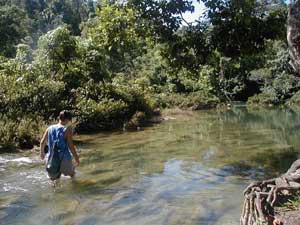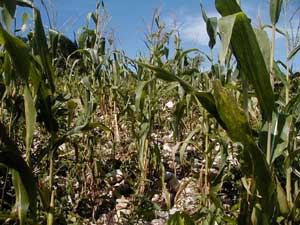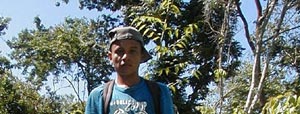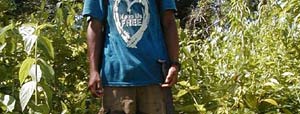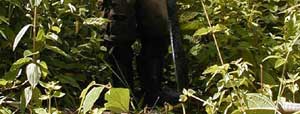|
|||
For
close to three years with sheer wonderment I stared down upon
the fold of my map of the Central American country of Belize at
the legend marker signifying the remote Maya site of Pusilha.
My first attempt to visit Pusilha fell short when the then visiting archaeologist from the University of California, San Diego, Dr. Geoffrey Braswell ended his digging season at odds with the local villagers of San Bonito Poite. We were tentatively scheduled to head up to the site to meet with Dr. Braswell when my wife and I ran into him one day on a street in Punta Gorda, the seaside capital of the Toledo District of southern Belize where most bush expeditions and archaeological teams pass through when exploring the Toledo. Seemingly rushed, Dr. Braswell informed us that it would be better to wait until the following season to insure the approval of the Belize Institute of Archaeology which oversees Dr. Braswell’s work at Pusilha. Plus, apparently in the last weeks of the annual dig a handful of locals prohibited Dr. Braswell and his team from entering the excavation sites. Although Dr. Braswell provides gainful employment for many of the male villagers, the process at times puts him at obvious odds with others. With perseverance, the second opportunity to reach Pusilha presented itself some months later when the yearly hurricane season which usually soaks a traditionally wet southern portion of Belize, turned out to be the driest four months in decades. Because of this meteorological anomalism the roads throughout the hills of the Toledo were dry and navigable for my twenty year old Toyota pickup. The truck has a long bed but no under clearance nor four wheel drive, so you have to pick and choose the off-road miles with care and calculation. With this in mind, I knew if the truck was ever to roam the back roads of Toledo, well this was the time to make the go of it. And so, after a wasted attempt spoiled by poor planning that led to a missed turn in the village of Santa Theresa the day before, I got up with the morning flocks of parrots to prepare right for the journey. Into a green bucket which I later placed in that open long bed of the Toyota, I tossed in four frozen bottles of Crystal water, three apples, two bananas, one rapidly melting Bounty chocolate bar and a single cola of Coke. Next to me there on the front passenger seat I placed alongside my digital camera and tattered map of Belize, a yellow legal pad to be used as a log book to make notations of my distances as well as to write descriptions of things that would inevitably catch my eye. I also brought along my Hunter rubber boots and my dull blade machete. Though one of the boots was now worn through on the bottom and despite the fact that that particular machete was browning with rust, my travels have taught me that a holey pair of Hunters and a dull machete are better than none in the bush. This day proved no exception. As my base camp was some eight miles inland from the coastline, my choices were quite limited to fuel up the Toyota before I began the adventure. I could either go back into the town of Punta Gorda, or I could travel to another set of gas stations at a road junction referred to as Dump. Since Dump was indeed on the way to Pusilha, I opted for the one further off the path of the two. I did so not because the gas was in any way better or with a higher octane, nor because their would be any savings since the gas was already well over BZ$8.00 (US $4.00) per gallon, a lot for even a gas frugal Toyota . No, I must admit that my thought process was driven purely by gluttony. For the distant station not only had good gas but it also sold fresh cut pieces of pound cake wrapped and ready for the passing road warriors of truckers and the like. Tearing open the cellophane wrapper from the first of my two pieces of pound cake I made a right turn down the hill at Dump and quickly transitioned from paved tarmac to dirt rock gravel surface, where I would remain for the next eighty-three miles. It took about forty five minutes to travel from Dump to Blue Creek, half way to Pusilha and the last outpost in the Toledo for most guide book travellers. From Blue Creek the road goes on for several miles to the village of Jordan before again crossing the Moho River. As the road then approaches Santa Theresa, there is a small dirt road to the right just before the school which lies in the centre of the village. After the turn in Santa Theresa the road becomes smoother due in part to less vehicle travel in general, reflected by the fact there were only two trucks at the end of the road in San Benito the day I arrived. And the road becomes a roller coaster of twist and turns as you go up over one hilltop after another alongside roadside fields of corn. All told and in just under two hours after I packed my water bottles and bananas into my bucket, I pulled up the hill and into the village of San Benito Poite. As it was early in the morning, school children scurried about with their exercise books and pencils placed neatly in plastic bags, all giggling and pointing at me and the mud covered Toyota that I had just seemingly landed in. |
Exiting the truck I immediately looked about for an adult or person of authority to focus my inquiries, you know, someone I could ask to point me in the direction of the local Alcalde. The Maya village Alcalde (Mayor) is the most important person in the local Maya culture and absolutely the person one should always check into with first and foremost when travelling into remote villages of the indeginous in Belize. This is especially important in the Toledo District. Unfortunately, upon my Monday morning arrival I was informed that the Alcalde for San Benito Poite had just headed off to work in the farming fields a few hills away. I was told this by Grace Harrington, a 23 year old South Austin Texan who was halfway through her two year stint with the United States Peace Corps. She explained that the Alcalde liked all visitors looking for Pusilha to start at his champa in order to properly distribute the tour guiding opportunities amongst the willing villagers of San Bonito. Although the system has all the best intentions, this day there was no one readily available. However, after some ten minutes of watching the Peace Corps volunteer negotiate amongst the village women, a young girl jumped on her bike and minutes later returned with a one Francisco Eck. |
||||||||||||
As
luck would have it, Mr. Eck had worked on the previous seasons
dig with Dr. Geoffrey Braswell. The villagers available for consultation
that day came to the conclusions that Francisco was the most knowledgeable
as well as the most available to hike into Pusilha. Lucky for
me, he turned out to be all of that as well as one of the best
guides I’ve had the pleasure to venture with.
Francisco and I came up with a price for his bush chopping services. The peace corps volunteer accepted my invitation to join us for the hike, and the three of us were off. Not ten minutes down hill from the centre of the village of San Benito, we came to the shoreline of the Moho River. As an old woman bathed herself and her grandchild, we walked around them and began to traverse through the water. The Peace Corps volunteer blazed the trail with her Teva sandals as Francisco offered me an arm to brace myself against the missteps I made all the way across the Moho. As we reached the opposite bank of the river and found our way onto stable ground, Francisco turned and walked down a quick and weathered trail to point out the mound protruding out of the center of the river. "Welcome to Pusilha…." |
|||||||||
 |
 |
 |
One
of the estimated hundred or more Mayan mounds at Pusilha located
along the shores of the upper Moho River in the Toledo District
of Southern Belize. |
 |
 |
 |
During my visit at Pusilha, Francisco Eck discovered that this Maya mound had been looted since his last visit to the site less than a week prior. With the artefacts now gone, pieces of the puzzle are missing forever that could have helped to enlighten us all about the life and times of the ancient Maya population at Pusilha. Of course, the artefacts sometimes don't go too far, as I was offered large pieces of blades of Jade in the centre of San Bonito Poite by two Maya women. The women brought the pieces to my car for viewing and told me that there is man in a brown Ford truck that comes to the village sometimes on Sundays in disguise of darkness to buy what they have to sell. |




